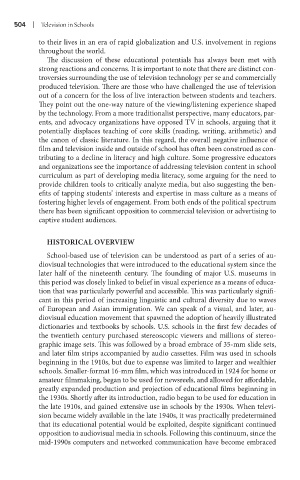Page 525 - Battleground The Media Volume 1 and 2
P. 525
0 | Telev s on n Schools
to their lives in an era of rapid globalization and U.S. involvement in regions
throughout the world.
The discussion of these educational potentials has always been met with
strong reactions and concerns. It is important to note that there are distinct con-
troversies surrounding the use of television technology per se and commercially
produced television. There are those who have challenged the use of television
out of a concern for the loss of live interaction between students and teachers.
They point out the one-way nature of the viewing/listening experience shaped
by the technology. From a more traditionalist perspective, many educators, par-
ents, and advocacy organizations have opposed TV in schools, arguing that it
potentially displaces teaching of core skills (reading, writing, arithmetic) and
the canon of classic literature. In this regard, the overall negative influence of
film and television inside and outside of school has often been construed as con-
tributing to a decline in literacy and high culture. Some progressive educators
and organizations see the importance of addressing television content in school
curriculum as part of developing media literacy, some arguing for the need to
provide children tools to critically analyze media, but also suggesting the ben-
efits of tapping students’ interests and expertise in mass culture as a means of
fostering higher levels of engagement. From both ends of the political spectrum
there has been significant opposition to commercial television or advertising to
captive student audiences.
hisToriCaL ovErviEw
School-based use of television can be understood as part of a series of au-
diovisual technologies that were introduced to the educational system since the
later half of the nineteenth century. The founding of major U.S. museums in
this period was closely linked to belief in visual experience as a means of educa-
tion that was particularly powerful and accessible. This was particularly signifi-
cant in this period of increasing linguistic and cultural diversity due to waves
of European and Asian immigration. We can speak of a visual, and later, au-
diovisual education movement that spawned the adoption of heavily illustrated
dictionaries and textbooks by schools. U.S. schools in the first few decades of
the twentieth century purchased stereoscopic viewers and millions of stereo-
graphic image sets. This was followed by a broad embrace of 35-mm slide sets,
and later film strips accompanied by audio cassettes. Film was used in schools
beginning in the 1910s, but due to expense was limited to larger and wealthier
schools. Smaller-format 16-mm film, which was introduced in 1924 for home or
amateur filmmaking, began to be used for newsreels, and allowed for affordable,
greatly expanded production and projection of educational films beginning in
the 1930s. Shortly after its introduction, radio began to be used for education in
the late 1910s, and gained extensive use in schools by the 1930s. When televi-
sion became widely available in the late 1940s, it was practically predetermined
that its educational potential would be exploited, despite significant continued
opposition to audiovisual media in schools. Following this continuum, since the
mid-1990s computers and networked communication have become embraced

